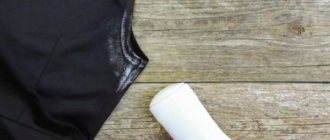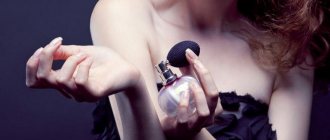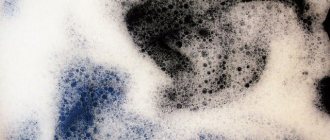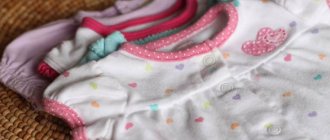Causes of yellow spots
How to remove yellow streaks and stains? Sometimes washing leaves strange, unattractive marks. The reasons for their occurrence may be different. To correctly determine where they came from and how to deal with them, pay attention to the following features:
- their location;
- rinsing intensity;
- how many clothes have them if you wash them in a machine.
Important! Based on these features, you will identify the nature of the origin of the spots. This will help you deal with the problem and eliminate the nuisance in a suitable way.
Yellow spots may appear on clothes after washing for the following reasons:
- clothes were stained with cosmetics - foundation, sunscreen;
- you sweat profusely and the fabric of your clothes is saturated with sweat;
- not completely dissolved detergent during machine washing.
Important! Find out also how to remove deodorant stains quickly and permanently without ruining the fabric of your items.
What should you consider when starting to deal with stains on clothes?
Stains from paint, oil, and food products are very difficult to remove with ordinary detergents. Most often you have to resort to strong chemicals, which, if used incorrectly, can damage the fabric itself. Before resorting to any cleaning method, you should familiarize yourself with the rules for washing the material from which the item is made.
What is the fabric made of?
It is most difficult to deal with stains on delicate fabrics such as silk, satin, and velvet. They should not be exposed to chlorine-containing bleaches; they also do not tolerate intensive washing.
How to determine whether the fabric will deteriorate when it comes into contact with the stain remover? Before soaking the entire item, you should apply a little chemical to the area near the seam on the wrong side and wait about half an hour. If the fabric has not deformed or lost color, then the entire product can be washed.
What is the origin of the stain?
The next parameter that needs to be taken into account when removing dirt is the origin of the stain. Depending on what the item was stained with - grass or fruit juice, grease, red wine, paint - you should choose a means to clean it.
How to remove yellow stains from clothes if you overdose on powder?
If you find that marks remain on many items after washing them in the machine, simply rinse them without detergent. After this, the undissolved powder will come off your clothes and your things will be fine.
In the future, to prevent this from happening again, take the following measures:
- Make sure that the machine is not overloaded.
- The water supply pressure should not be low.
- Follow the manufacturer's instructions carefully and add the specified amount of detergent.
Important! Learn how to machine wash shirts so you won't have to deal with powder stains again.
Recommendations for caring for white clothes
White items require special care. To preserve the original appearance for a long time, you must follow certain rules:
- Make sure that detergents are completely dissolved in water;
- do not wash white items at the highest temperature setting;
- rinse things thoroughly to remove any remaining powder and other detergents;
- use water softeners;
- periodically dry things that have been stored in the closet for a long time;
- try to wash clothes as they become dirty;
- Avoid products with chlorine, otherwise sweat stains may darken more;
- Avoid deodorants containing aluminum.
Clothes of light and dark shades get dirty equally, but on black and colored fabrics the dirt is not so noticeable.
Following care instructions, timely washing and proper storage of white items will reduce the likelihood of yellow stains appearing. However, it is not always possible to avoid contamination, and then traditional methods and household chemicals come to the rescue. If you wash things in time, yellow stains will easily come off the fabric.
How to remove yellow stains on things from cosmetics and sweat?
Every housewife has encountered stains from sweat and cosmetics, and each has her own effective way to deal with them. Typically, traces of them appear in characteristic places: under the arms, on the cuffs and collar. Below you will find out what and how you can remove such contaminants.
The most popular product is laundry soap, but even that is not enough. You have to use stronger drugs. To fight effectively you will need:
- soda;
- alcohol;
- vinegar;
- hydrogen peroxide;
- salt.
Important! You have all or some of these products in your kitchen or medicine cabinet. You can safely use them to remove yellow stains from white, colored and black clothes. The main requirement is to use the appropriate preparation for each type of tissue.
Features of removing stains from jeans
Comfortable and non-staining clothing for American workers, jeans eventually spread from America throughout the world. In order for your favorite denim pants to last as long as possible and not lose their neat appearance ahead of time, you need to know how to care for them.
Recently, a new trend has been actively gaining popularity - not to wash denim items, but to clean them dry, for example, to remove dirt with brushes. Fans of this approach believe that this method can significantly increase the life of the item and protect it from fading and loss of shape. However, it is impossible to remove old stains from jeans using the dry method.
The best option for caring for items made from denim material is not to go to extremes and wash the product in the usual way (in a washing machine or, if this is not possible, by hand), having first read the information on the label about the washing mode. Following the recommendations, you can remove old stains, but it will also refresh the item and return it to a presentable appearance.
But there is one caveat. In order to remove fresh stains from denim, it still makes sense to use the advice of “dry wash” adherents: wait until the stain dries, and then try to remove it with a brush using gentle movements. If you soak the stained area, the fabric may fade at the stained area. The dry washing method will help remove dirt and avoid the unpleasant fading effect (but only in some cases - when the stain is small, and not too bright or not deeply ingrained).
Dry washing denim is presented in this video:
Recommendations for caring for denim and washing it properly include important nuances:
- You need to wash a denim product as it gets dirty;
- it is better to do this manually, in cold water, using mild detergents;
- Before putting a denim item in the washing machine, you should turn it inside out, fasten the buttons and zipper, and take everything out of the pockets;
- the optimal water temperature for soaking is up to 40 ° C (if you process the product in boiling water, it may shrink and lose its shape);
How to remove yellow spots?
Before removing yellow spots, remember: the products are applied topically. Do not under any circumstances dump or pour components into the washing machine. These preparations are intended for hand washing. There are several methods for quickly and easily removing stains.
Method 1
One of the safest and most effective means to remove yellow stains from clothes after washing is baking soda. Follow these step-by-step instructions when using:
- Mix ¼ tbsp. water and 4 tbsp. soda
- Apply the mixture to the problem area and leave for 2 hours.
- Rub thoroughly with a brush and wash as usual.
Method 2
This method should be used with caution on colored clothing. It involves water, vinegar or alcohol, and they can lead to discoloration of certain areas on items, after which you will not be able to restore the fabric. The wardrobe item will simply have to be thrown away.
To prevent this from happening, remove yellow stains from white clothes after washing as follows:
- Mix vinegar or alcohol with water in equal quantities.
- Wet the stains well with the solution.
- Wipe with your hands.
- Wash and dry.
Method 3
Hydrogen peroxide works great to remove stains from a white shirt if you use it like this:
- Stir 1 tbsp in 1 liter of water. peroxide.
- Soak partially or completely the item in the solution for 30 minutes.
- Wash, rinse and dry the shirt.
Method 4
The option using table salt is perfect for white cotton, silk and linen items. Salt will remove traces of sweat and restore the whiteness of your T-shirts, shirts and pants.
Follow the suggested scheme and you are guaranteed an excellent result:
- Dissolve 1 tbsp in one glass of warm water. salt.
- Stir thoroughly and apply to the stain.
- Leave for several hours.
- Wash and dry.
Method 5
Especially for housewives who are not afraid of radical methods of dealing with difficult stains, there is an ancient method of boiling clothes. It is well suited for cotton fabrics. To comply with the rules of procedure and safety precautions, follow these instructions:
- Pour the required amount of water into a suitable container.
- Grate laundry soap or pour in a little bleach.
- Place on the stove and light the fire.
- Place clothes in water and cook for 2 hours.
- Remove the item from the boiling water and rinse.
- The method is not troublesome, but effective.
Important! Also find out what mode to wash T-shirts on so that after washing they are really clean and not stained.
What you need to know before removing stains: precautions
The most effective and easiest way to get rid of stains is to use dry cleaning services. However, this does not mean that this method is the safest.
It is necessary to take into account that dry cleaning specialists may not be able to undertake the removal of some old stains, but at home this task can be easily accomplished, the main thing is to act competently, taking into account the composition of the fabric, the type of stains and the degree of their age.
You shouldn’t delay the process of removing stains from clothes: fresh stains are much easier to remove than old ones, especially from items that have been washed several times. The old stain has already been influenced by external factors, thanks to which it has become difficult to remove.
To a greater extent, this is typical for oil and grease stains, but organic stains that have oxidized and become tightly attached to the fibers can also cause a lot of grief. That is why, when removing old stains, the risk of damaging the structure of the material is very high.
There are several types of stains:
- Fatty. Pork fat and oil stains are characterized by the absence of clear contours. Fresh ones are much darker than clean fabric, sticky to the touch, old ones lighten over time, eating into the fibers and appearing on the other side.
- Low-fat. Stains of organic origin (fruit juices, coffee, teas), on the contrary, have clear boundaries. Color - yellow or brown, outlines are always darker.
- Oxidized. They are secondary formations that have reacted with external factors. They are the most difficult to remove.
- Combined. Such stains are left by blood, eggs and other substances that combine the signs of the first two types of pollution.
Depending on the origin of the stain, the method of treating the contaminated surface will vary.
The first step in removing stains is to clean the fabric from dirt and dust, which can complicate the removal process by creating an additional “halo.” At the same time, you need to know that when removing stains, use strong alkaline and acid-containing preparations, as well as various types of solvents, with caution. The first can damage the structure of wool and silk, the second - linen and cotton, the third - artificial materials.
Information about the composition of the fabric can be found on the label, where manufacturers indicate the characteristics of the material and the rules for caring for the product.
Before treatment, you need to test the effect of the stain remover on an inconspicuous area of the fabric.
Removing fresh stains
If the blueberry juice just gets on the fabric, it will take some time to drain out before it is completely dry.
- Quickly bring the kettle to a boil.
- Stretch the dirty surface of the cloth, for example, over a sink (it is recommended to use a helper for this).
- As soon as the water in the kettle boils, pour the strip into a gentle stream of hot water. Thus, one person will stretch the fabric, and the other will pour boiling water.
Hot water will only help get rid of fresh stains.
Hot water has a detrimental effect on fresh blueberry and red wine stains, almost completely discoloring them. Treatment with boiling water may not withstand the shedding of multi-colored items, carpets, sofas, so it is advisable to make them only from white fabrics.
Attention! The boiling water treatment method only works on fresh stains; dried berries are indifferent to hot water.
Pharmacy products
In addition to kitchen products, you can also use chemical cleaning methods, which are equally effective.
Ammonia
The liquid is used for wiping or soaking. It is convenient to apply alcohol using cotton wool or a cotton pad. This will remove the blueberry juice stains from the edge to the center so they don't smear even more.
You can also use gauze instead of cotton wool.
Hydrogen peroxide
For white items, it is best to use peroxide as it will bleach the color pigments. Because it is relatively effective against blueberry juice, liberal application of a cotton pad or cotton swab will almost completely discolor the purple stain and prepare the fabric for further washing.
How can you remove black flies?
Dark spots from flies, flycatchers or bedbugs look especially unpleasant and even disgusting if they are not removed in time.
It is best to deal with them as soon as they appear, as it will become more difficult later.
Sticky black stains can be removed from clothing or upholstery using the following products:
- Ammonia. The product must be diluted with warm water, observing the proportions of 1:10. Next, you need to moisten a sponge in the solution and carefully treat the damaged area. It is important to do this starting from the edges, smoothly moving to the center of the product. After this, the item should be washed as usual, and if it is upholstery, wipe thoroughly with a cloth soaked in clean water;
- If the stain has formed on light-colored clothing, you need to fill it with a solution of one tablespoon of peroxide and two hundred milliliters of water. Let sit for thirty minutes, and then run the wash as normal;
- If the mark is dry or you need to remove a stain on very thick fabric, use regular purified gasoline. It will remove the stain, and in order to get rid of the smell, you need to soak the item in a soapy solution and then wash it several times as usual.
Choice of product depending on the material
The paste from a ballpoint pen penetrates deeply into the fibers of the fabric, is difficult to wipe off, but does not leave streaks. Ink from gel copies spreads quickly and spreads over a large area of the product.
To deal with a blot or stain, when choosing a liquid or powder to remove pen marks, you need to consider what fabric the shirt is made of.
| Material | Optimal cleaning agent |
| Wool | milk, soda, citric acid, glycerin |
| Linen, cotton, chintz | hydrogen peroxide, Domestos, White, acetone, vinegar |
| Synthetics | alcohol, toothpaste |
| Suede | soapy water, eraser |
| Natural silk | mustard, starch, hydrogen peroxide |
Ink from a pen on synthetic blouses and shirts can be removed with laundry soap, but you should not rub the stained areas with force, as the items may become deformed or torn. Whitening toothpaste can be used to clean both natural and artificial fabrics.
Why are blueberries difficult to wash?
Blueberries contain extremely durable natural dyes - anthocyanins, which, after drying, are strongly absorbed into any fabric, turning it blue or purple.
blueberry spots
The dye is so stable that it is used as a natural pigment when dyeing jeans and other fabrics. But its durability is not always useful, especially when it comes to removing dirt from children's clothes.
Other natural dyes, such as tea and coffee, are also difficult to remove from fabric.
Professional stain removers
If the ink cannot be washed off, cannot be wiped off with ethyl or ammonia, or does not respond to household products, purchase special stain removers containing chemicals.
When purchasing, we advise you to carefully read the instructions, which indicate what fabrics the product is suitable for:
| Name | Approximate price of packaging in rubles |
| Eared nanny | 130 |
| Vanish | 225 |
| Bos plus | 85 |
| Typhoon | 320 |
| Clean Home | 320 |
| Frosch | 220 |
Liquid stain removers are rubbed into the fabric right before washing.
You will find proven methods and means for removing marks from gel and ballpoint pens in this section.
Application of washing powders
Modern washing powders and gels contain bleaches, bioadditives and active substances that wash away grease and remove stains from pens and felt-tip pens.
| Name | Approximate price for 3 kg in rubles |
| Ariel Expert | 530 |
| Tide Color | 470 |
| Burti Color | 670 |
| Persil Sensitive | 400 |
| Reflect | 330 |
Universal laundry detergents wash away fresh traces of a pen, but do not always cope with blots embedded in the fabric. The dosage of the powder is indicated on the packaging.










